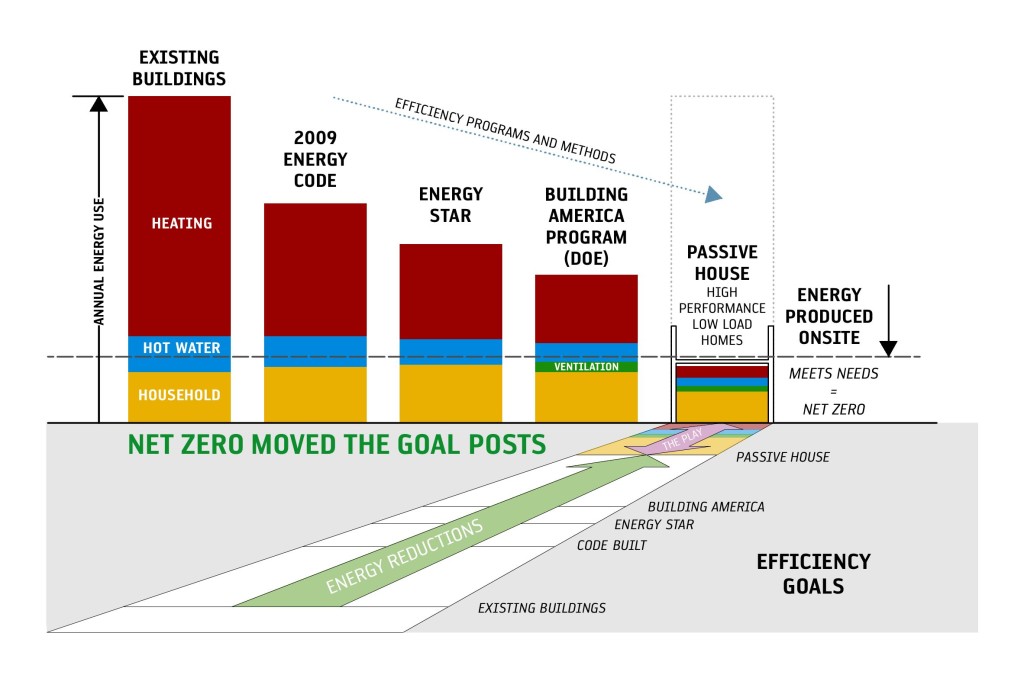 This is a story about where we live and the energy we use to live there and the tantalizing prospect of actually producing all the energy we need on an annual basis – its a new way of thinking about building what are called Zero Net Energy homes.
This is a story about where we live and the energy we use to live there and the tantalizing prospect of actually producing all the energy we need on an annual basis – its a new way of thinking about building what are called Zero Net Energy homes.
The best place to start is to quote Dorothy: “There’s no place like home.” As shelter buildings protect us – provide comfort – and serve our practical needs. As homes they delight and renew us – nourish our social relationships – and are often the hub of our active lives. To do all this they use energy – and we have been in the habit of buying all the energy we need to serve our home’s requirements in the form of fuel delivered and electricity produced by others – and we measure our use by the payments we make.
We use that energy mostly to provide thermal comfort, hot water, and another good chunk to operate mechanical systems and all our homes electrical stuff. As the expense of energy has increased homes have become more efficient thru building codes, energy saving programs, and innovative design methods like Passive House. Over time, the cost to produce electricity with PV’s, along with rebates and incentives, has made it possible to produce some of that energy on site, and mostly on roof tops. And as buildings become more efficient and PV’s more affordable a new goal line has come into view – the ability for a home to actually produce as much energy as it needs – these are called Net Zero Homes, or Net Zero for short.
If Net Zero has become our new goal line, where did we receive the ball? Well, to employ that metaphor, let’s say our existing buildings, the ones most of us live in, have the ball at the twenty, like after a kickoff. Our existing homes can be hard to keep comfortable, and cost a lot to do it. Because they don’t work so well we depend on all sorts of workarounds – there are aisles at Home Depot with portable heaters, humidifiers and dehumidifiers, air cleaners and air conditioners, and of course, fans – all with their own additional energy costs. Its enough to tap our puritan ethic – turn down the thermostat and put on a sweater. We can take advantage of an energy audit and probably advance the ball about ten yards, or get serious and take on projects called Deep Energy Retrofits and get the ball to the fifty yard line, about as far as its possible to take an existing home.

New homes are different. A home built to the next version of the Building Code, in other words any home being built – will be starting at the fifty – but also staying there. That is one thing about building a home. It is embedding its values IN time. Colonials, Victorians, Mid-Century Moderns; they
each express the idea of home and its functions that people valued when they were built. Our McMansions say a lot about the past couple decades. Where are we headed? Well, further down the field.
Houses built to the Energy Star for homes standard get us into field goal range – around the 35 or 40 yard line. These are much higher performance homes and use significantly less energy than what we have been building. Can we advance further. Can we get inside the twenty to the red zone? Well that is what Passive House accomplishes. This rigorous method of building what are called high performance, low load homes – inspired by the US solar movement from the ‘70’s and re-engineered in Germany in the 90’s – has returned to the US and is inspiring some of the most efficient homes in the country. We’re ready to score!
Our next play will get us to the goal line – the miserly amount of energy a high performance home needs is so small that it can be completely satisfied by the PV’s that fit on its rooftop – they’re producing all the energy they need on an annual basis. This same amount of PV’s on most homes will just satisfy the household electrical loads – nice, but not Net Zero.
So Net Zero homes are an impressive accomplishment, who wouldn’t want an energy bill of zero! But energy efficiency isn’t the only thing that makes these homes different. We’re used to buildings that leak air, are different temperatures in different rooms, can feel stuffy or too dry, and may even be causing health problems – all the result of the way they were built. They may also be vulnerable to ice dams, mold or other indoor air quality issues, or even be causing building materials to rot.
High performance homes like Passive House do just the opposite. They are consistently comfortable at stable temperatures everywhere in the building, have a constant source of filtered fresh air contributing to health and cleanliness, and are robustly durable – no ice dams or mold – so long lasting and low maintenance. They use simple systems that are easy to maintain and make smart use of solar energy streaming thru large south facing windows. Floor plans are open and spaces are bright and cheerful. These aren’t just optimized machines, they are delightful homes.
How do these homes achieve such impressive performance? Well, to borrow from Apple’s marketing campaign, they are “Built Different” They depend on five integrated strategies – starting with a simple shape and orientation to the sun, then building with levels of super insulation – like an explorer headed to the arctic they wear a thick coat – in this case one that completely envelops the building, even beneath the foundation slab. This envelope is also “thermal bridge free” – it avoids building details that have materials that can conduct heat from inside out. All this slows the rate at which the building loses energy to a trickle – one reason the indoor environment is so stable.
The carefully sized and located high performance windows gain more energy than they lose – actually outperforming the thick walls. This is therefor called net gain glazing and is part of the free heat that gives the building a big energy advantage. The other source of free heat is actually our own bodies – we generate heat – and so does our electronic equipment and our appliances. When the building loads get this small these free gains help.
Most homes lose energy thru air leaks – called ventilation losses. These homes are essentially air tight – eliminating what is otherwise a big liability. Unlike most homes that depend on unpredictable leakiness to provide fresh air – these homes breathe using a system of balanced ventilation – a constant and equal exchange of indoor and outdoor air at a rate that supports good health – and with the added virtue of being able to capture the heat in the air that would otherwise be leaving the house and transferring it to the incoming air. This is called heat recovery ventilation and it is a remarkable technology.
So what are the challenges? Let’s answer cost right off – because that is a question everyone rightly asks. The added construction costs are, not surprisingly, for more insulation and better windows. There is some additional framing, but also a much smaller and simpler mechanical system. All totaled these add appx. 5-8% to the cost – though we are comparing apples to oranges here. The PV system, while heavily subsidized (for now anyway) still requires an investment of $10-20K – though there are also lease options. What you are buying with these up front investments is a predictable energy operating budget of zero! That level of performance is now embedded in the building for as long as it lasts.
Expertise matters in these projects and an integrated project team is essential. They depend on designers with a solid grounding in building science, a construction manager who can communicatae technnnical details and coordinate with the trades, and some new players: an energy engineer (just as we wouldn’t imagine building without structural engineering), a specialist in solar systems, as well as a third party to verify compliance with programs that provide incentives like Energy Star (which can total as much as $10,000 for the building alone) or the CT Zero Energy Challenge.
This third party applies the metric for the buildings HERS report, an important benchmark that rates building efficiency in comparison to that code built home. HERS stands for Home Energy Rating System – think of it like a cars MPG rating, but for a house. These raters assure the buildings will perform as promised.
This brings us to realtors, banks and appraisers. While more and more states are requiring a HERS report as part of an MLS listing so that home buyers can compare energy use when shopping for homes, these industries have been slow to catch up with the effect that no utility cost has on both loan qualification and long term value. For an industry that relies on comps of similar buildings that have sold, there are too few of these remarkable buildings for them to compare – a real catch 22.
So why so few? There are many reasons, all pretty much related to the ways in which these homes are so different, and so new to most people. Some of the materials are not a phone order a way at the local supply houses, and some of the methods need to be learned. Most new homes are built by merchant builders and the equation for success there is curb appeal and low cost – and back to that HERS report – no good way to assess, and therefor to value the efficiency, or experience the remarkable comfort that are part of these homes value proposition.
The latest report on climate change from the IPCC emphasizes yet again how urgently we need to change the way we think about and build homes (American homes use almost 25% of the energy consumed in the United States. About 80% of that energy is used in single-family homes). Net Zero Homes make a serious contribution to meeting that challenge
Net Zero is the new goal line. We know how to reach it because we already are. No matter where you are on the field, there’s a way to march toward that goal.

